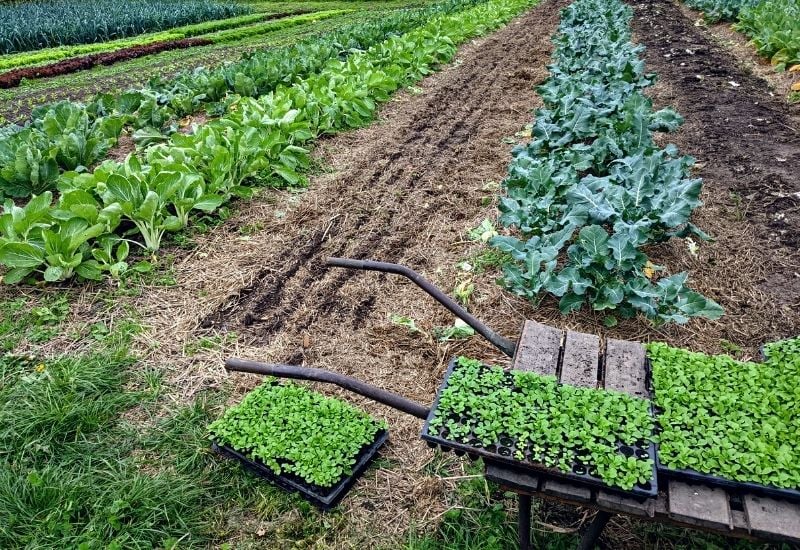
When it comes to controlling weeds in the home vegetable garden, mulching is one of the best tools a gardener has at their disposal, but it does far more than this.
Mulching your vegetable garden will not only keep weeds in check, but it will retain moisture, regulate the temperature of the ground, feed the soil, and reduce insects and other pests.
So what is the best mulch to use in your vegetable garden? Almost anything can be used mulching vegetable garden beds, from straw to wood, cardboard, newspaper, wool, compost, leaves, and more.
Choosing a mulch and deciding when to use it in your vegetable garden depends on the particular needs of your plantations, your soil and what material is locally and sustainably available.
let’s look at how and why to use mulch around your plants plus we’ll look at the different materials so you can choose the best mulch for your vegetable garden or a bed.
Benefits Of Mulching A Vegetable Garden
Mulching has many benefits for the vegetable garden. Though applying mulch can be labour intensive, the short- and long-term benefits are well worth the effort.
Here are some ways that mulch helps your garden grow:
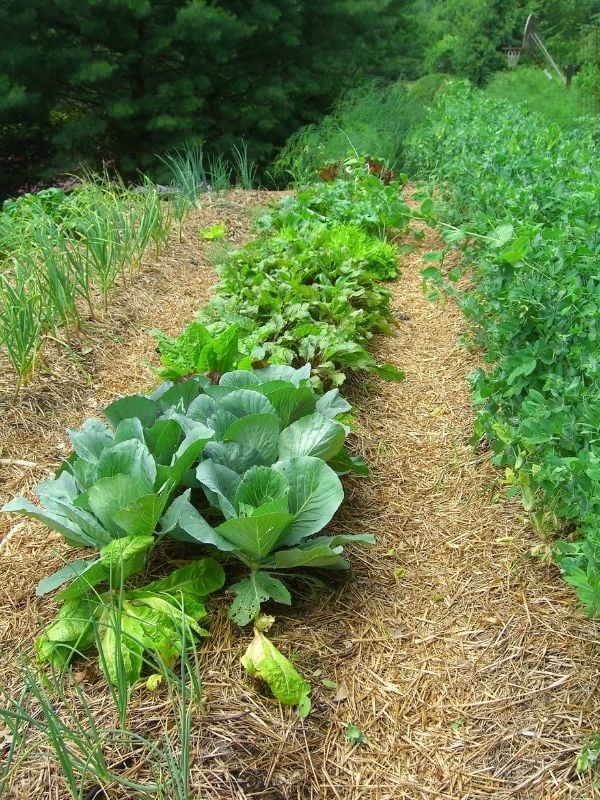
How To Choose The Right Mulch For Your Vegetable garden
Which is the right mulch to choose? We will look at the benefits of each type of material later, but before you choose a mulch, it is important to ask yourself a few questions:
What do I want the mulch to do? Look at the ways above that mulch will help your garden and determine what you want from your mulch.
Which plants am I going to mulch? Every plant in your garden has different needs and can be better suited to a particular mulch.
What is available? It is more environmentally sound to choose a mulch that is readily and locally available in your area.
Am I going for aesthetics or practicality? Some mulches are better for ornamental uses, while others can have a more practical application in the vegetable garden.
How long will the mulch last? Some mulches, such as woodchips, take a lot longer to decompose than straw for example. On the flip side, the straw will break down faster and provide more immediate food for the soil.
Pros & Cons of the Black Plastic Used in Vegetable Gardening
What about plastic mulches? What place do they have in the vegetable garden? Plastic mulches, such as landscape fabric, tarps, or black poly can be used with great success in the vegetable garden and we have used many different kinds with good results.
However, plastic mulches should be used with care as they have potential downsides.
The first thing to consider is the potential health concerns. All plastic leaches chemicals, even food safe plastic, and you must decide if you are ok introducing these substances into your vegetable plot.
Plastic mulches, such as old tarps or black plastic sheeting, are very effective at choking out weeds, but they can also heat the soil to the detriment of soil bacteria and earthworms. In short, your soil can become “dead”.
The heat generated by plastic mulch can really benefit heat-loving crops such as tomatoes, peppers, or eggplant but it can burn out cool-season vegetables.
Furthermore, the plastic does not allow water through, so your soil will quickly dry out and a lack of water stresses plants and leads to disease, slow growth, and poor yield.
Consider removing plastic mulch in the heat of summer, running drip irrigation lines underneath, or cutting slits in the plastic for water to enter.
Landscape fabric, also called weed barrier, can work very well as a seasonal mulch but it should be used with care.
Weeds and grass will grow through it if it is left in the garden for multiple years, becoming a weed-infested mess that is very difficult to remove. The same can happen if rocks, dirt, or other mulch are put on top of it.
When Is the Right Time to Mulch Your Vegetable Garden?
You can apply mulch to your garden any time of the year but from may to early autumn is the best time to mulching your vegetable garden.
Mulch will benefit your garden in any month of the year, but here are the main reasons for mulching through the seasons:
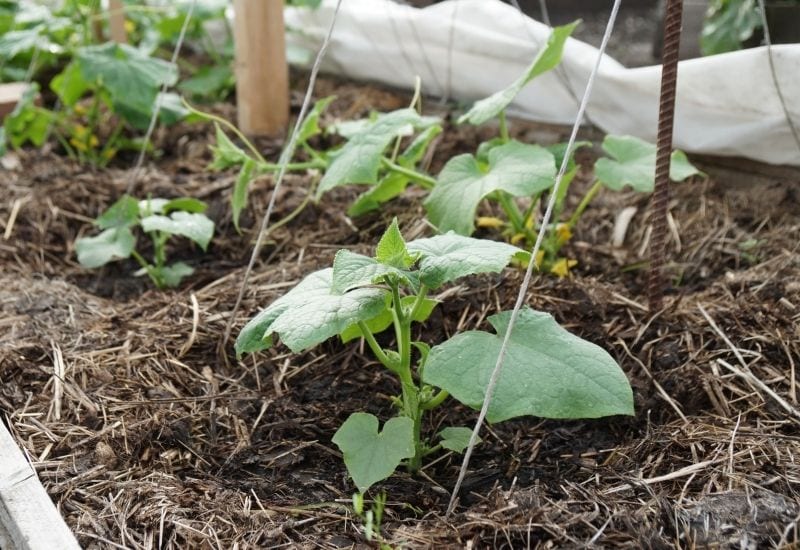
Spring: One of the best times to put down mulch is in the spring before plants have started to grow. Weeds grow in the spring, so adding mulch in the spring control weeds so they won’t choke out your germinating seedlings can sprout. You should wait until the soil has warmed up in the spring before mulching your garden.
Summer: In hot climates, applying an organic mulch keep your soil cool under the blazing sun and retain moisture for the hot, dry spells.
Fall: It is preferable to apply mulch in fall so that it has time to decompose before the spring plantings, this to avoid a possible ‘starvation of nitrogen’ and and give you a jump start next year to have a weed-free spring.
Winter: in mild or rainy areas, winter mulch will prevent erosion. In cold climates, it will protect roots, earthworms, and other soil organisms from freezing. Laying down mulch in the the winter also prevents the leaching of nutrients while maintaining the biological activity of the soil, which will transform the mulch into rich, well-loose humus.
Can I Mulch Right Up To A Plant?
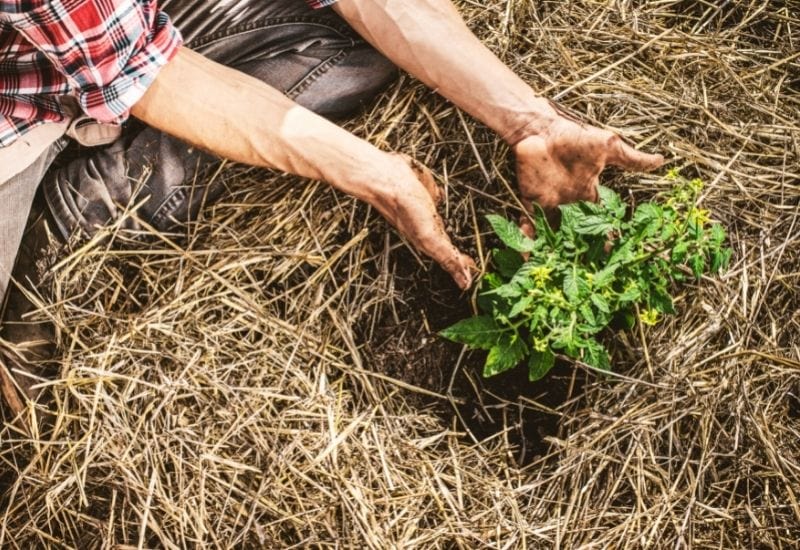
Putting mulch right up to the stem of a plant can trap too much moisture and can introduce disease or cause the plant to rot. Avoid hilling mulch right against a plant and keep mulch 2cm to 8 cm (1-3 inches) away from the base of the plants.
Does Mulch Attract Insects?
No, but many insects, such as slugs, can be drawn to the warm and damp environment it creates. Some mulch, like wood bark, can attract termites or carpenter ants.
Does this mean I shouldn’t use a mulch? Not in the least! Anytime there is an infestation of any insect or animal it is because of an unbalanced ecosystem, and not the fault of the mulch. After all, it is not the bugs’ fault that we created a perfect home for them.
To reduce or eliminate “pests” that are attracted to your newly mulched garden, try and create a natural environment that will keep these invaders in check. Here are a few natural ways to reduce insects in your mulch:
Best Organic Mulches For The Vegetable Garden
Now, let’s take a look at the different kinds of organic mulch you can use in your vegetable garden.
Depending on your garden’s needs, you can have great results using two or more of them together. For example, putting straw on top of cardboard which is our go-to mulch.
These organic vegetable garden mulches are more beneficial to your soil, plants and the environment.
1: Cardboard

Cardboard is a great mulch for the vegetable garden, especially when topped with a thick layer of organic matter such as straw.
If you use cardboard on its own, make sure to keep it damp or it will shrivel in the sun and blow away in the wind. Cardboard will break down by the following year but will do a wonderful job of smother weeds and feed the earthworms before it does.
To mulch with cardboard, first remove any staples and tape from the boxes. Lay the cardboard on the soil or directly on top of weeds. Overlap the edges so weeds do not grow between the sheets. Two layers of cardboard works significantly better than a single layer.
Grocery stores will usually give you old boxes, making cardboard a free, environmentally friendly option for your garden.
2: Using Newspaper as Mulch

Newspaper works similar to cardboard and also makes a great bottom layer to organic mulch. On its own, it permeates moisture better than cardboard, but it will quickly blow away if it is dry.
Most newspaper is now printed on soy-based ink making them safe for use around vegetables, but some areas still use toxic chemicals so check with your local printing presses to be sure. To mulch with newspaper, lay down a thick layer (around 10 sheets) for best results.
You can put it right on the soil, or over top of weeds though it is difficult to lay flat if the weeds are thick or tall.
Give the newspaper a good soaking to keep it in place while you are working.
Newspaper does not last as long cardboard, but will still suppress weeds for most of the growing season. You can till it right into the soil at the end of the year and it will help build the soil.
3: Straw
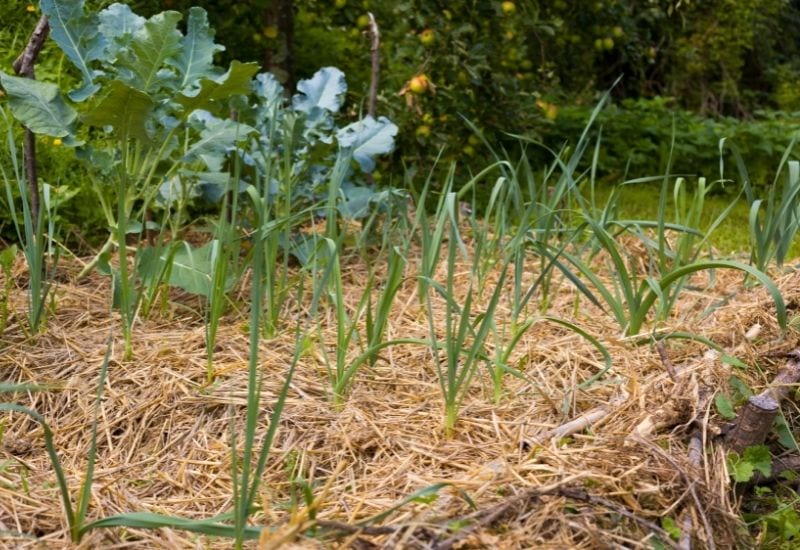
Straw is another great mulch option, and can usually be picked up for quite cheap. It will usually last a year or two, at which point you can till it into the garden, put another layer of mulch on top, or pull it up and toss it in the compost.
On its own, straw is not great at smothering weeds but it is awesome when put on top of cardboard or newspaper.
Any weeds that do grow through straw can easily be pulled as mots of the root will be feebly rooted in the straw. If the straw becomes infested with weeds, you can roll the whole thing up, weeds and all, and have a nice clean garden bed underneath.
To mulch with straw, put down a layer that is about 15cm (6 inches) thick. Straw is easily applied over large areas but can also be carefully placed around individual plants.
Straw is not the same as hay.
Straw is the stalks from a grain crop while hay is mature grass that has been cut and dried for animal feed. Hay is full of seeds and should be avoided as a mulch in the vegetable garden.
Good quality straw will not have weed seeds, though sometimes you might get a bad bale that introduces weeds to your garden. Occasionally, you will have wheat, oats, or another grain sprout from seeds that were left in the straw.
This is nothing to worry about and you can either let the grains grow and harvest them for yourself or till them under as a green manure.
4: Plywood
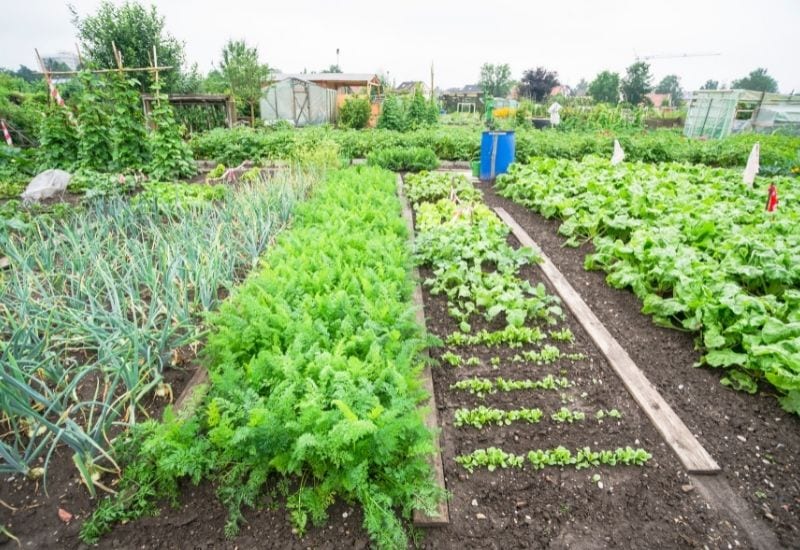
Laying sheets of plywood as a mulch is a great way to smother thick, tough weeds and prepare a spot for a new garden bed. While the plywood is choking out the weeds, earthworms and other beneficial organisms will thrive in the moist environment under the plywood.
Put sheets of plywood directly on top of sod or other weeds and leave them for a year or two. Plywood sheets should last for many years when used in this fashion.
This also works well to keep the weeds down on temporary pathways.
5: Wool
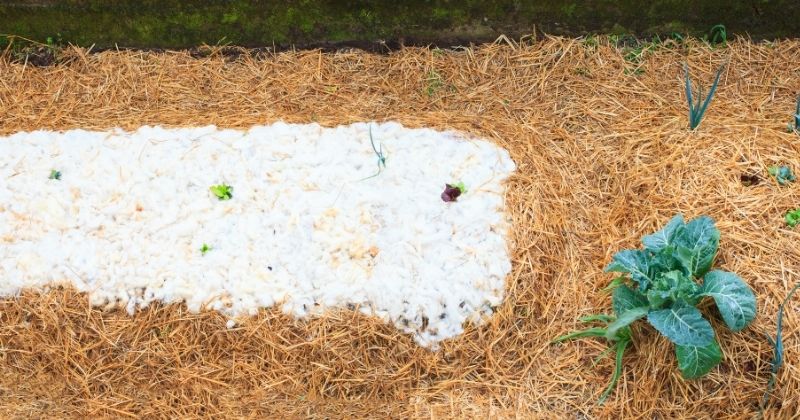
Mulching with wool is an old practice that has slowly died out with the advent of modern agriculture.
However, many gardeners still use wool as a mulch and new studies are being done about the benefits of wool mulch in commercial farm operations. You can buy specialized wool mats or wool pellets designed particularly for the garden, or you can take raw wool (right off the sheep’s back) and lay it down in your garden.
Wool will hold 30% of its weight in water before it even feels wet, so it is a great way to preserve moisture in your garden. It is also an amazing insulator and will help regulate the temperature of your soil.
Since it takes a long time to decompose, wool will keep your plants mulched for a long time. Weeds, especially tough grasses, will grow through wool over time.
Apply cardboard under the wool to help suppress the weeds, and use a fairly thick layer (at least 15cm).
6: Chopped or shredded leaves

The best way to attract earthworms to your garden is to mulch with leaves. A leaf mulch is also one the best ways to add humus to your soil.
To mulch with leaves, put down about 5 to 10 cm (2-4 inches) of dry leaves. You can shred them first or leave them whole. Shredded leaves will break down faster to feed your plants, while whole leaves will matt together more to smother weeds better and retain more moisture.
You can transplant directly into the leaves, or till them in the following year once they have become leaf mould. (Tilling in leaves the first year can deplete nitrogen from the soil).
7: Compost
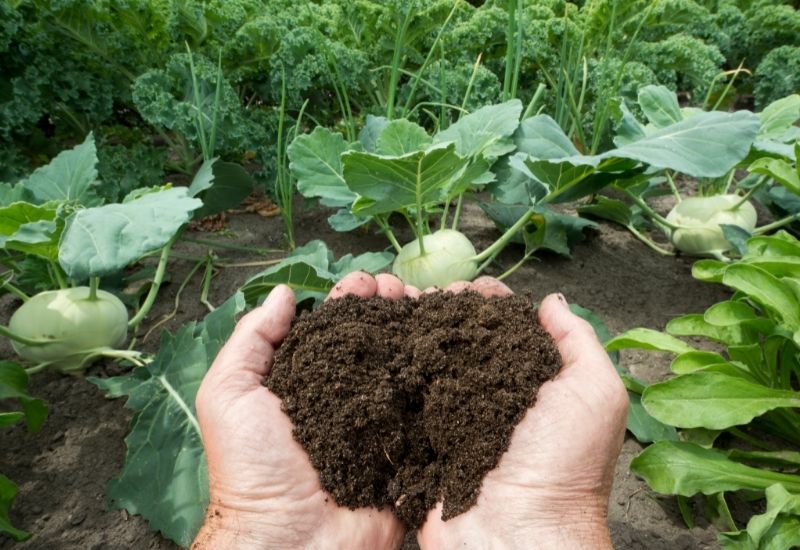
Compost is perhaps the best thing you can give to your garden, so it is no wonder that is also works well as a mulch.
While compost is not as effective at suppressing weeds, it will feed the plants, improve the soil, and its dark color will help warm the soil for an early spring planting.
The best advantage of mulching with compost is that you can sow your seeds right into it.
Compost is best applied as a mulch in the spring so the young plants can make the most of the nutrients and the nutrients are not leached over winter, but your garden will still benefit from a compost mulch any time of the year.
A thin layer is all that is necessary, about 2cm to 3cm (1 inch) thick, to replace the nutrients that were lost from the previous harvest.
8: Woodchips And Shavings
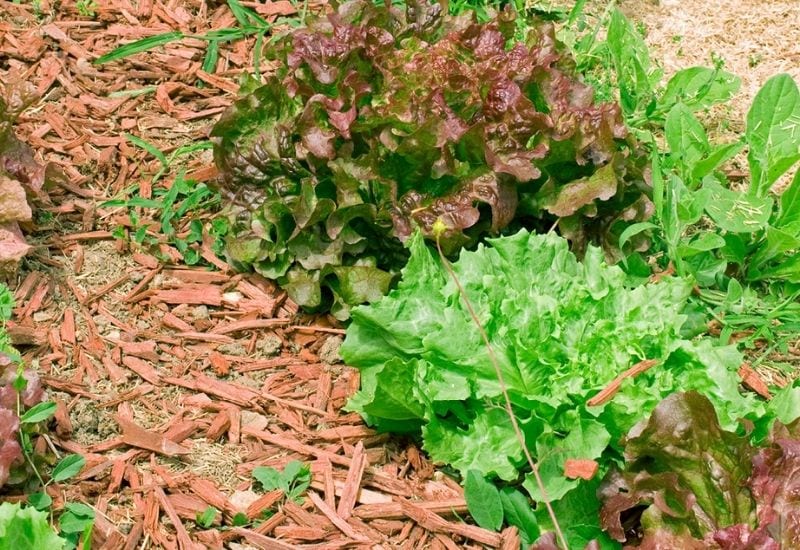
Woodchips and shaving are an ideal mulch for trees because they replicate a forest floor. Another advantage of woodchips, bark, and shavings is that they take a long time to decompose, so they will provide a natural mulch for 4 to 6 years.
The main disadvantage of woodchips is that they take nitrogen from the soil as they decompose. This can cause problems if they are overused in the vegetable garden, and nitrogen-deprived plants will suffer from yellowing leaves, inhibited growth with a poor yield.
9: Grass clippings
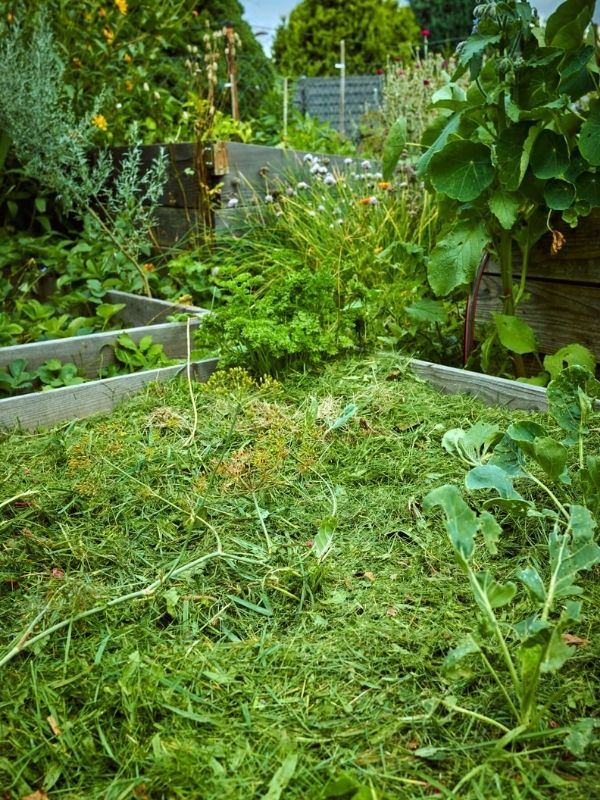
Grass clippings can form a thick, dense mass that will choke out weeds and retain moisture in the soil. Grass clippings can be easily collected with a mower with a bag attachment, and can be put on your garden in a 10cm (4 inch) deep layer.
Do not use grass clippings if the grass had gone to seed or if it was treated with hericides or pesticides as these will contaiminate your vegetable garden.
Conclusion
Mulching is nothing new. Not only have gardeners and farmers been doing this for centuries, but nature has been mulching since time immemorial.
Every times the leaves fall from a tree, or when grass on the prairies withers and is flattened by a heavy snow fall, nature is creating an organic mulch that feeds the land and protects the soil from erosion.
By replicating the nature whorl, we are creating a perfect environment for growing that is healthy for the land, the water, and ultimately for us, too.

Written By
Amber Noyes
Amber Noyes was born and raised in a suburban California town, San Mateo. She holds a master’s degree in horticulture from the University of California as well as a BS in Biology from the University of San Francisco. With experience working on an organic farm, water conservation research, farmers’ markets, and plant nursery, she understands what makes plants thrive and how we can better understand the connection between microclimate and plant health. When she’s not on the land, Amber loves informing people of new ideas/things related to gardening, especially organic gardening, houseplants, and growing plants in a small space.

Hi, I am new to gardening and want to make walkways around my raised beds. What would be good to use? Wood chips? Straw? Rocks?
I was going to use wood mulch but saw you say that wood mulch would discourage polinators. Any advice would be greatly appreciated.
The best mulch materials for vegetable garden pathways I have found (so far), are a double layer of cardboard covered with oak and pine sawdust.